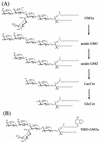Utilization of ganglioside-degrading Paenibacillus sp. strain TS12 for production of glucosylceramide
- PMID: 12406710
- PMCID: PMC129906
- DOI: 10.1128/AEM.68.11.5241-5248.2002
Utilization of ganglioside-degrading Paenibacillus sp. strain TS12 for production of glucosylceramide
Abstract
Gangliosides, sialic acid-containing glycosphingolipids, are membrane constituents of vertebrates and are known to have important roles in cellular differentiation, adhesion, and recognition. We report here the isolation of a bacterium capable of degrading gangliotetraose-series gangliosides and a new method for the production of glucosylceramide with this bacterium. GM1a ganglioside was found to be sequentially degraded by Paenibacillus sp. strain TS12, which was isolated from soil, as follows: GM1a --> asialo GM1 --> asialo GM2 --> lactosylceramide --> glucosylceramide. TS12 was found to produce a series of ganglioside-degrading enzymes, such as sialidases, beta-galactosidases, and beta-hexosaminidases. TS12 also produced beta-glucosidases, but glucosylceramide was somewhat resistant to the bacterial enzyme under the conditions used. Taking advantage of the specificity, we developed a new method for the production of glucosylceramide using TS12 as a biocatalyst. The method involves the conversion of crude bovine brain gangliosides to glucosylceramide by coculture with TS12 and purification of the product by chromatography with Wakogel C-300 HG.
Figures








References
-
- Arita, M., M. Iwamori, T. Higuchi, and Y. Nagai. 1983. Negative ion fast atom bombardment mass spectrometry of gangliosides and asialo gangliosides: a useful method for the structural elucidation of gangliosides and related neutral glycosphingolipids. J. Biochem. (Tokyo) 94:249-256. - PubMed
-
- Boldin, S. A., and A. H. Futerman. 2000. Up-regulation of glucosylceramide synthesis upon stimulation of axonal growth by basic fibroblast growth factor. J. Biol. Chem. 275:9905-9909. - PubMed
-
- Buchanan, R. E., and N. E. Gibbons (ed.). 1974. Bergey's manual of determinative bacteriology, 8th ed. The Williams & Wilkins Co., Baltimore, Md.
-
- Falk, P., L. C. Hoskins, and G. Larson. 1990. Bacteria of human intestinal microflora produce glycosidases specific for lacto-series glycosphingolipids. J. Biochem. (Tokyo) 108:466-474. - PubMed
Publication types
MeSH terms
Substances
LinkOut - more resources
Full Text Sources
Other Literature Sources
Molecular Biology Databases

